Anti-thrombotic strategies for microfluidic blood processing
Abstract
The redundant mechanisms involved in blood coagulation are crucial for rapid hemostasis. Yet they also create challenges in blood processing in medical devices and lab-on-a-chip systems. In this work, we investigate the effects of both shear stress and hypothermic blood storage on thrombus formation in microfluidic processing. For fresh blood, thrombosis occurs only at high shear, and the glycoprotein IIb/IIIa inhibitor tirofiban is highly effective in preventing thrombus formation. Blood storage generally activates platelets and primes them towards thrombosis via multiple mechanisms. Thrombus formation of stored blood at low shear can be adequately inhibited by glycoprotein IIb/IIIa inhibitors. At high shear, von Willebrand factor-mediated thrombosis contributes significantly and requires additional treatments with thiol-containing antioxidants—such as N acetylcysteine and reduced glutathione—that interfere with von Willebrand factor polymerization. We further demonstrate the effectiveness of these anti-thrombotic strategies in microfluidic devices made of cyclic olefin copolymer, a popular material used in the healthcare industry. This work identifies effective anti-thrombotic strategies that are applicable in a wide range of blood- and organ-on-a-chip applications.



 Please wait while we load your content...
Please wait while we load your content...